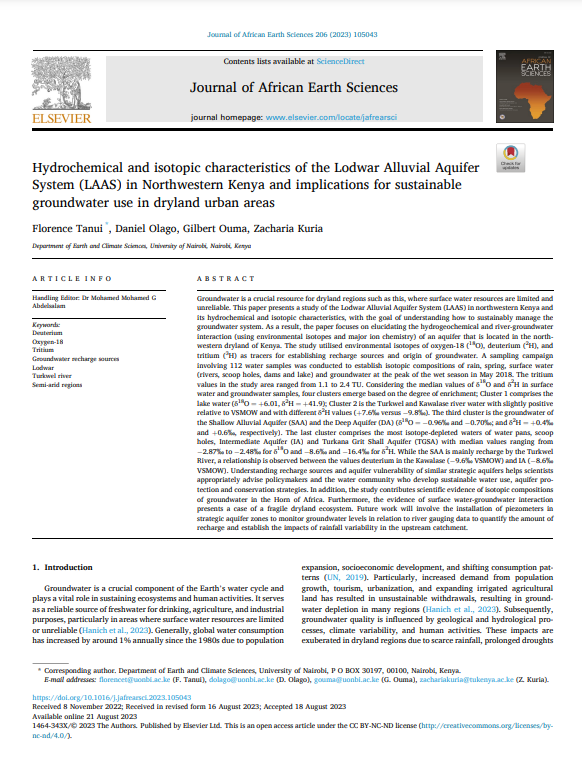Florence Tanui, Daniel Olago, Gilbert Ouma, Zacharia Kuria
Groundwater is a crucial resource for dryland regions such as this, where surface water resources are limited and unreliable. This paper presents a study of the Lodwar Alluvial Aquifer System (LAAS) in northwestern Kenya and its hydrochemical and isotopic characteristics, with the goal of understanding how to sustainably manage the groundwater system. As a result, the paper focuses on elucidating the hydrogeochemical and river-groundwater interaction (using environmental isotopes and major ion chemistry) of an aquifer that is located in the north-western dryland of Kenya. The study utilised environmental isotopes of oxygen-18 (18O), deuterium (2H), and tritium (3H) as tracers for establishing recharge sources and origin of groundwater. A sampling campaign involving 112 water samples was conducted to establish isotopic compositions of rain, spring, surface water (rivers, scoop holes, dams and lake) and groundwater at the peak of the wet season in May 2018. The tritium values in the study area ranged from 1.1 to 2.4 TU. Considering the median values of δ18O and δ2H in surface water and groundwater samples, four clusters emerge based on the degree of enrichment; Cluster 1 comprises the lake water (δ18O = +6.01, δ2H = +41.9); Cluster 2 is the Turkwel and Kawalase river water with slightly positive relative to VSMOW and with different δ2H values (+7.6‰ versus −9.8‰). The third cluster is the groundwater of the Shallow Alluvial Aquifer (SAA) and the Deep Aquifer (DA) (δ18O = −0.96‰ and −0.70‰; and δ2H = +0.4‰ and +0.6‰, respectively). The last cluster comprises the most isotope-depleted waters of water pans, scoop holes, Intermediate Aquifer (IA) and Turkana Grit Shall Aquifer (TGSA) with median values ranging from −2.87‰ to −2.48‰ for δ18O and −8.6‰ and −16.4‰ for δ2H. While the SAA is mainly recharge by the Turkwel River, a relationship is observed between the values deuterium in the Kawalase (−9.6‰ VSMOW) and IA (−8.6‰ VSMOW). Understanding recharge sources and aquifer vulnerability of similar strategic aquifers helps scientists appropriately advise policymakers and the water community who develop sustainable water use, aquifer protection and conservation strategies. In addition, the study contributes scientific evidence of isotopic compositions of groundwater in the Horn of Africa. Furthermore, the evidence of surface water-groundwater interaction presents a case of a fragile dryland ecosystem. Future work will involve the installation of piezometers in strategic aquifer zones to monitor groundwater levels in relation to river gauging data to quantify the amount of recharge and establish the impacts of rainfall variability in the upstream catchment.

